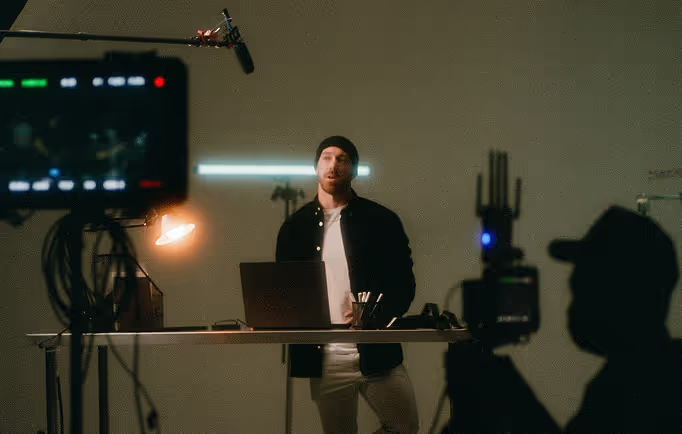How important is creativity in business?

It’s easy to think that creativity in the workplace is a luxury only afforded to those working in artistic fields. Heck, here at Explanimate our whole thing is to show off the creative side of your brands and organisations. But even those of us who work in the arts can get bogged down by the monotony of the nine to five grind. Creativity is found both in day-to-day business practice, company structure, and in advertising for the business – but how important is it to purposely work creativity into promoting your own business practice?
Our findings? Very. But it’s reasonable to ask: what exactly is it about a creative flair that helps a brand grow, attract new customers, and develop more useful ideas? Here are our top thoughts on the topic of creativity:
1) it’s a differentiator
A sense of creativity helps separate an otherwise overlooked idea from one that can grab people’s attention. In new technology fields for example, great startup ideas can be missed by potential audiences simply due to a lack of understanding of what the product or service actually does. And in established fields, quality products can be passed over just because they appear too similar to established ones, without the hook of brand recognition.
This is where creativity in design and advertising comes in. To put it simply, a solid creative approach to advertising a brand helps lay the foundations for a unique, memorable brand identity. A striking example can be seen in the creativity of Spotify’s original explainer campaign. In a time where streaming services were both new and burgeoning, Spotify differentiated themselves with a dialogue-free promo explainer video which expressed a no-nonsense, easy to use, ‘all about the music‘ image. No voiceover, no technical terms, no explanation of how it works – just a black, white, and green animated video with a strong focus on the words ‘music’ and ‘easy’.
2) it helps attract a new customer base
A creative advertising strategy like this can also help corner niche markets not normally associated with your brand or product. An example now considered a modern classic of advertising is ‘The Man Your Man Could Smell Like’ campaign from Old Spice. You know, that super-viral “I’m on a horse” ad from 2010? The creative and somewhat unusual approaches in this campaign had a double pronged success with audiences.
Firstly, prior to this campaign Old Spice was widely considered an outdated cologne, often jokingly associated with “smelling like your grandpa”. Some Old Spice deodorant products have even embraced this stereotype by sporting the self-deprecating label: “If your grandfather hadn’t worn it, you wouldn’t exist”. But back to the ad campaign – by using a comedically fast-paced script with out of the ordinary non sequiturs, the ad targeted a much younger demographic who were used to the bite-sized and often absurdist humour of internet culture. By creatively derailing from a traditional advertisement structure the ad avoided alienating the younger audience who had, at the time, become desensitised to traditional marketing lingo.
Secondly, instead of aiming the ad at the intended users of the product – adult men – it instead takes a lateral approach by speaking directly to the predicted purchasers of the product – straight women, who purportedly comprised the majority of body wash purchases. In a literal sense the star of the ad speaks to the “ladies” viewing, and is designed to be exaggeratedly appealing to women. But between the lines the ad also picks up the remaining male purchaser audience by speaking not to, but about men, repeatedly using the word “man”, suggesting ideals for men to attain to in order to attract the ladies the ad speaks to. It’s a complex creative strategy pulled off in a surprisingly simple way, which is the beauty of a creative advertisement approach.
3) it helps find new solutions
One of the greatest assets about creativity is that it naturally fosters flexibility. Creativity is about using the imagination to develop original ideas – whether that’s from a springboard of other concepts or a by finding a new way of tackling problems. Essentially, creativity is about possibilities.
In certain high-changing industries, like new technology startups and app-based services, creative thinking is vital to coping with changes in the industry. Once technological limits are breached creativity then becomes the deciding factor in how to develop and utilise the new digital landscape in useful ways. And until those breaches happen, creativity allows developers to explore the current limits of technology in ways which haven’t yet been exploited.
conclusion: how to foster a creative business practice
Over 1,500 global IBM chief executive officers voted creativity as the most important asset for future success, and it’s not hard to see why given the benefits for audience growth and adaptability. Beyond hiring creative companies to help promote your brand, there are several smaller ways to develop a greater flow of ideas within your company:
hire talented people from a range of backgrounds.
We all have different lifestyles and worldviews, and sometimes those views, when unquestioned, can leave us stuck in an echo chamber of our own ideals. Not everyone will have a natural knack for creativity (or communicating that creativity effectively), but giving a platform for different viewpoints and skill sets can trigger fresh ideas not considered before.
make your workplace a creative ‘safe zone’.
Nothing hinders the creative process more than feeling like you’ll be reprimanded for thinking outside the box. Creativity requires a chain of thought, and encouraging that chain by rewarding innovation (even if it doesn’t ultimately pan out) helps get more of those ideas out there. Learning to be comfortable with failure and with sounding out bad ideas is a crucial step to getting to the good ideas.
value rest time.
If fear is creativity’s Lex Luthor, then burnout is creativity’s kryptonite. Set up time for the brain to recharge between projects, set up reasonable work hours, or consider trialling a flexible work arrangement to foster healthy, happy workers. Evidence shows that well-used rest time in turn helps us to become much more productive in our work time.
Start a






